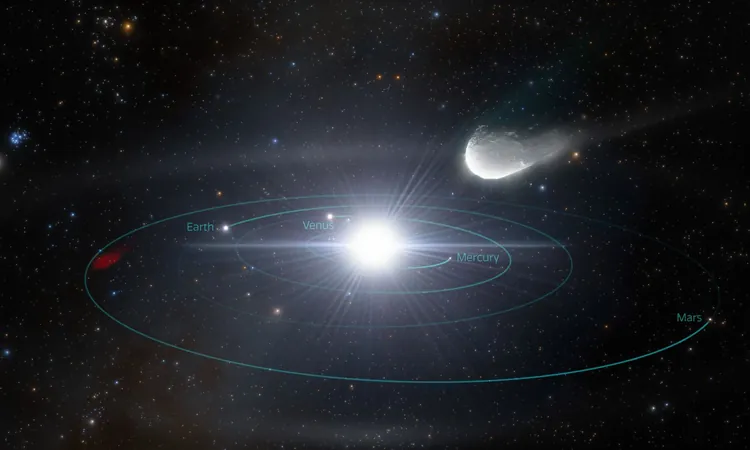
Can Interstellar Objects and Rogue Planets Become Permanent Residents of Our Solar System?
2024-12-05
Author: Amelia
Introduction
In 2017, a mysterious object named 'Oumuamua made headlines as the first confirmed interstellar object (ISO) to glide through our solar system. Then in 2019, Comet 2I/Borisov followed suit, marking the second documented visit from the vast interstellar expanse. While these two ISOs are the only confirmed visitors to date, it's widely believed that many more have traversed our solar system throughout its long history. Excitingly, the upcoming Vera Rubin Observatory is expected to uncover a plethora of new interstellar travelers.
Gravitational Capture of Rogue Planets
But how exactly does a rogue planet or an ISO get ensnared by our Sun’s gravitational embrace? The answer lies in a complex mathematical construct known as phase space.
Imagine a scenario where a massive rogue planet enters our serene solar system. The outcome would depend on the mass and orbital dynamics of this newcomer. While the odds of such an event drastically altering life on Earth are slim, it certainly raises intriguing possibilities. A recent research note published in Celestial Mechanics and Dynamical Astronomy offers insight into how such captures might occur, under the insightful work of Edward Belbruno from Yeshiva University and James Green, a former NASA scientist.
Understanding Phase Space
Phase space is a multidimensional construct representing the various states of a dynamic system, like our solar system. It establishes a framework where one can analyze both the position and momentum of celestial bodies, allowing scientists to understand the possible orbital configurations around the Sun.
Within this phase space, there exist two main types of capture points: weak and permanent. Weak capture points offer a temporary, semi-stable orbit, akin to a gentle gravitational nudge. In contrast, permanent capture points foster stable orbits from which bodies cannot escape. Notably, the dynamics of these points allow for transitions between weak and permanent states, depending on the specific characteristics of ISOs or rogue planets.
Research Findings
In their paper, Belbruno and Green explore a unique perspective on permanent capture, stating that it can occur without the possibility of escape, despite challenges in achieving a consistent stable orbit. This is influenced by the complex gravitational interactions within our solar system, including the role of the Milky Way's tidal forces.
The possibility of rogue planets, which are thought to exist in staggering numbers, also plays a significant role in this phenomenon. As stars form in clusters, the gravitational interactions can hurl some planets into interstellar space, creating rogue planets abundant in our galaxy. The researchers note that the final arrangement of solar systems often stems from processes of scattering and gravitational influences from neighboring stars.
Implications for Our Solar System
But what does this mean for our solar system? By quantifying the solar system's phase space, the researchers have estimated how many rogue planets might be lurking nearby. In the vicinity of our solar system—around six parsecs from the Sun—are approximately 131 stars and brown dwarfs, many of which might be hosting undiscovered planets.
Encouragingly, about every million years, the trajectory of neighboring stars brings them within a few light-years of Earth. In the next 50,000 years, six stars are predicted to make close passes, enhancing the likelihood that their gravitational effects might dislodge icy bodies from the Oort Cloud—an immense sphere of icy debris surrounding our solar system—potentially sending them into the inner solar system.
Possibilities for Interstellar Travelers
These interactions brew opportunities for ISOs to slip into permanent weak capture zones, particularly the areas located approximately 3.81 light-years from the Sun, as detailed in the researchers' findings. They argue that if an ISO or rogue planet approaches one of these openings, it could enter the Sun’s Hill sphere—a region dominated by the Sun’s gravitational pull—where chaotic movements might lead to permanent capture without the risk of a cataclysmic collision.
Conclusion
Understanding these mysterious bodies is still in its infancy, but the hunt for ISOs and rogue planets could soon unveil shocking revelations about our cosmic neighborhood. With the Vera Rubin Observatory set to explore these possibilities in depth, it may soon become clear whether we have potential interstellar visitors that may ultimately call our solar system home. The cosmos is full of surprises, and we are only beginning to decipher its secrets!



 Brasil (PT)
Brasil (PT)
 Canada (EN)
Canada (EN)
 Chile (ES)
Chile (ES)
 Česko (CS)
Česko (CS)
 대한민국 (KO)
대한민국 (KO)
 España (ES)
España (ES)
 France (FR)
France (FR)
 Hong Kong (EN)
Hong Kong (EN)
 Italia (IT)
Italia (IT)
 日本 (JA)
日本 (JA)
 Magyarország (HU)
Magyarország (HU)
 Norge (NO)
Norge (NO)
 Polska (PL)
Polska (PL)
 Schweiz (DE)
Schweiz (DE)
 Singapore (EN)
Singapore (EN)
 Sverige (SV)
Sverige (SV)
 Suomi (FI)
Suomi (FI)
 Türkiye (TR)
Türkiye (TR)
 الإمارات العربية المتحدة (AR)
الإمارات العربية المتحدة (AR)